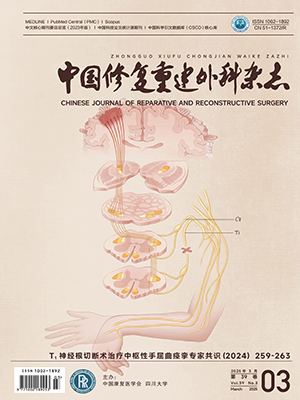Objective To explore the cl inical effectiveness of debridement in treatment of Pes anserinus bursitis under arthroscopy by comparing the curative effect of three therapies: local block therapy, open operation and debridement under arthroscopy. Methods From January 2000 to January 2007, 90 cases of unilateral Pes anserinus bursitis were treated with debridement under arthroscopy (group A, n=30), local block therapy (group B, n=30) and open operation (group C, n=30),
respectively. The group A included 18 males and 12 females, aged (40.0 ± 2.5) years old; the locations were left knee in 16 cases and right knee in 14 cases; 10 cases had injury history, 7 cases had tired history and 13 cases had no obvious inducement; the course of disease was (24.0 ± 3.2) weeks. The group B included 17 males and 13 females, aged (37.0 ± 2.5) years old; the locations were left knee in 15 cases and right knee in 15 cases; 10 cases had injury history, 8 cases had tired history and 12 cases had no obvious inducement; the course of disease was (26.3 ± 3.5) weeks. The group C included 16 males and 14 females, aged (39.8 ± 2.2) years old; the locations were left knee in 18 cases and right knee in 12 cases; 8 cases had injury history, 10 cases had tired history and 12 cases had no obvious inducement; the course of disease was (25.0 ± 3.9) weeks. There was no statistically significant difference in the general data among three groups (P gt; 0.05). Results All patients were followed up 15 months on average (12-24 months). In group C, the inflammatory reation occurred at wound in 9 cases (30%) at 3-10 days after operation and was cured after symptomatic management; other incision healed by first intention; and showing statistically significant differences when compared with other 2 groups (P lt; 0.05). In group C, joint swell ing occurred at 1 week after operation in 1 case, l imitation of joint motion in 2 cases at 10-12 weeks after operation and was recovered after symptomatic management. In group B, 21 cases (70%) had a recurrence at 6-12 months after operation, all patients of other 2 groups had no recurrence; showing statistically significant differences between group B and groups A, C (P lt; 0.05). At last follow-up, the pain remain rates were 3.3% (group A), 0 (group B) and 33.3% (group C), and the compl ication incidence rates were 3.3%, 26.7% and 70.0%, respectively; all showing statistically significant differences among three groups (P lt; 0.05). At last follow-up, there were statistically significant differences in the visual analogue scale (VAS) score, the HSS score, and range of motion (ROM) between preoperation and postoperation in group A (P lt; 0.05); there was no statistically significant difference in the VAS score, HSS score and ROM between preoperation and postoperation in group B (P gt; 0.05); the ROM of postoperation in group C was smaller than that of preoperation (P lt; 0.05). There were statistically significant differences in the VAS score and HSS score between group A and groups B, C (P lt; 0.05), and in ROM among three groups after operation (P lt; 0.05). Conclusion The treatment of Pes anserinus bursitis with debridement under arthroscopy has advantages of easy-to-do, less compl ication, low relapse rate and good functional rehabil itation.
Citation: YAN Changbao,CHEN Baicheng,SHAO Decheng,KANG Huijun,LIU Hu,WANG Shaohong,LI Jia.. TREATMENT OF PES ANSERINUS BURSITIS WITH DEBRIDEMENT UNDER ARTHROSCOPY. Chinese Journal of Reparative and Reconstructive Surgery, 2009, 23(9): 1045-1048. doi: Copy
Copyright © the editorial department of Chinese Journal of Reparative and Reconstructive Surgery of West China Medical Publisher. All rights reserved




